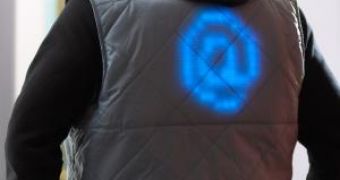Electroluminescence in organic materials was first produced in the 60s by applying a high-voltage alternating current (AC) field to crystalline thin films of acridine orange and quinacrine.
An international research project has begun that could help bring to mass-market organic light emitting devices (OLEDs), which could have far reaching technological implications and cut the cost of lighting by billion of pounds each year.
An organic light-emitting diode (OLED) is any light-emitting diode (LED) whose emissive electroluminescent layer comprises a film of organic compounds. The layer usually contains a polymer substance that allows suitable organic compounds to be deposited. They are deposited in rows and columns onto a flat carrier by a simple "printing" process. The resulting matrix of pixels can emit light of different colors.
Such systems can be used in television screens, computer displays, portable system screens, advertising, information and indication. OLEDs can also be used in light sources for general space illumination, and large area light-emitting elements. For now, the devices are used as displays in some mobile phones and MP3 players, but they are not reliable enough for larger screens such as in TVs and computers as they stop working after a few months.
But since an international consortium of researchers, led by the University of Bath, UK, has begun an ?850,000 ($1,700,000), three-year project to put the science behind the devices on a firmer basis, important steps are expected to be taken into making them efficient enough to be worth producing for the mass market.
The devices are thin and flexible, so lighting and electronic display screens could for the first time be created on almost any material, so that clothes and packaging can display electronic information.
Modecom is a consortium that consists of 13 groups from nine universities and two companies. Three groups are from the UK, six from the USA, and one each from China, Belgium, Italy and Denmark. The European Union is funding the European and Chinese partners.
It is coordinated by Dr Alison Walker, of the University of Bath's Department of Physics, who said: "This is a long-term project, and the contributions of many scientists are needed for its success. The experimentalists make measurements to test the efficiency of the devices, but it's hard to get a clear picture of what is going on at present. This project is about making that picture clearer using computer models to develop the theory. Success in achieving the goals of cheap, efficient and long lasting devices is essential as we must do everything we can to reduce our energy costs."
The market is eagerly waiting for the new products, and many possible applications have already been foreseen, like transparent windows (like a conventional window during the day, but when it gets dark a switch is turned on and the entire window area emits light in a more efficient way than conventional or energy saving bulbs, promising huge savings).
Another one would be clothing which displays strips of the polymer which run off solar power, allowing electronic messages to be displayed which can be updated. This could be useful for the emergency services such as police or ambulance. They could even change color at the press of a button.
Or maybe in packaging for common goods that could be made to display electronic messages such as health warnings and recipes, or could emit light.
These are just some of the possibilities, and many more will surely appear, since marketing ideas never seem to come to a halt.

 14 DAY TRIAL //
14 DAY TRIAL //